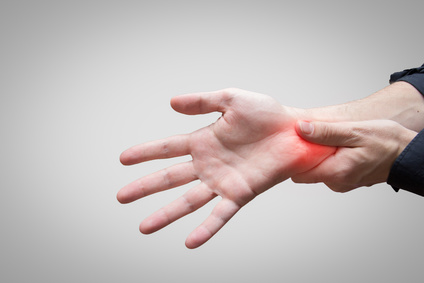Carpal Tunnel Syndrome: 101
Carpal Tunnel Syndrome (CTS) affects thousands of Americans. If you spend hours a day tapping away at a keyboard, you could be one of them…
Carpal tunnel syndrome is a disease of the hand that is characterized by numbness, tingling, weakness, and pain. It is one of the most common disorders of the hand and is a result of compression of the median nerve as it crosses the wrist and enters the hand. The median nerve is one of the major nerves in the arm, and provides sensation to the thumb, index, and middle fingers. As the median nerve travels across the wrist, it passes through a “tunnel” composed of bone and ligaments. People with CTS have increased pressure in their carpal tunnel compared to unaffected people. This increased pressure compresses the median nerve and leads to the classic symptoms of CTS (numbness, tingling, pain).
CTS affects up to 5% of the population and is more commonly found in women than in men. Although CTS can result from things like a broken wrist, it usually has no clear cause. It does, however, have several risk factors such as diabetes, hypothyroidism, rheumatoid arthritis, pregnancy, and alcoholism. It has been thought that repetitive motions such as keyboarding may play a role in CTS; however, studies have failed to show a connection between the two.
The most common symptoms of CTS are numbness, tingling, or pain in the thumb, index, and middle fingers. One may notice a weakness in the hand or find oneself dropping objects more than usual. CTS can also make it difficult to handle small objects, such as buttoning a shirt. Finally, patients commonly find that the symptoms are worse at night, and may even wake them up on a regular basis.
Mild cases of CTS can usually be managed by nonsurgical methods. Wearing a removable wrist brace can help to relieve the symptoms, especially when worn at night. The brace helps to support the wrist and hold it in a position that reduces the pressure placed on the median nerve. Medications such as NSAIDs may provide some symptomatic relief, but are unlikely to cure CTS. If CTS persists despite bracing, then one should seek medical treatment. Longstanding, untreated CTS may result in permanent nerve damage that can cause numbness and weakness in the hand.
When bracing fails to control the symptoms of CTS, a physician may offer the patient a steroid injection into the carpal tunnel. This can be an effective short-term treatment for CTS, but only 20% of patients remain symptom-free 12 months after steroid injection.
The most reliable long-term treatment of CTS is surgery. The goal of the surgery is to cut a ligament in the palm which will take pressure off of the median nerve in the carpal tunnel. Surgical release of the carpal tunnel has a success rate greater than 93%. Surgery is performed on an outpatient basis and is usually performed through a small incision in the palm. Newer techniques offer the ability to perform minimally invasive carpal tunnel surgery. This involves cutting the ligament from the “inside” while the surgeon watches through a “scope.” Minimally invasive carpal tunnel offers smaller incisions and a shorter recovery period.
After surgery, the hand is placed in a soft dressing and patients are able to move their fingers immediately. Patients usually return to light work about 2-4 weeks after surgery. Most patients do not require any therapy after surgery.
In summary, carpal tunnel syndrome is a common, treatable condition that results from compression of the median nerve as it crosses the wrist. Mild cases can be treated with braces and over-the-counter medication. More advanced cases are treated with surgery. Carpal tunnel surgery is a reliable treatment with a short recovery time allowing a return to work in 2-4 weeks.
If you are suffering from painful symptoms of CTS, please contact us here for an appointment to discuss your treatment options.
Keep up with Texas Orthopedics news by following us on Facebook and Twitter (@TexasOrthopedic).



